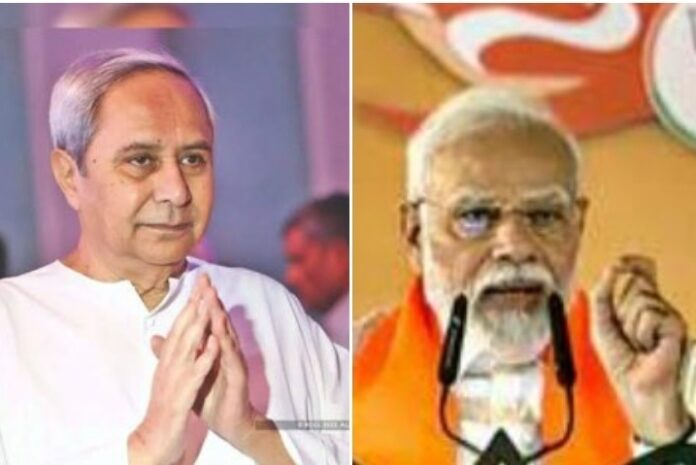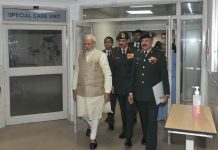By Dr Padmalochan Dash
GANDHINAGAR: In the kaleidoscope of Indian politics, few leaders have crafted a legacy as enduring as Naveen Patnaik, the untiring Chief Minister of Odisha. So does Prime Minister Narendra Modi, whose charismatic leadership enabled the BJP to secure sizable numbers of MPs in the last election in the state of Odisha, despite challenges such as scarce ground workers, weak booth management, and a significantly smaller budget compared to that of the BJD and even the Congress party. This time, electoral politics in Odisha remains a direct battle of narratives between two leaderships, and the result depends on whom the people of Odisha choose as the fittest for what responsibilities.
Naveen’s Fortes vs BJP’s Flakes
Key Concerns: Naveen Patnaik’s political strengths lie in his emphasis on inclusive politics- defined on his own terms. He has actively built coalitions that transcend traditional divisions based on caste, community, and religion. This claimed approach has not only broadened his support base but also minimized the impact of divisive factors that often characterize Indian politics-influencing the voting patterns. Over time, this successful experiment of vote-consolidation has made the BJD government appears to be neglecting significant societal issues, such as the influx of illegal migration.
For illustration, the issue of lakhs of illegal Bangladeshis settling across Odisha over the last few decades remains a significant concern. Local estimates suggest a substantial number of illegal immigrants settling in various areas, leading to increased criminal and terrorist activities. Despite being reaming the core agenda for the BJP and a grave issue for the people and state of Odisha, the somewhat inexperienced party leadership in the state has largely ignored and failed to hold the state government into action.
On welfare schemes: Naveen’s implementation of welfare schemes and populist measures, such as Mission Shakti and KALIA, has been a cornerstone of his political strategy. These initiatives, aimed at empowering women and supporting farmers, have effectively captured the imagination of targeted demographics, solidifying support for the BJD. On the other hand, similar schemes introduced by the Modi government have struggled to resonate convincingly with the people. The state leadership of the BJP has failed to effectively communicate these schemes to the public, relying instead on superficial social media posts.
Women Voters: The BJD has successfully implemented schemes like affordable healthcare and subsidized rice distribution, endearing CM Naveen Patnaik to the masses. Rural women, in particular, remain convinced that Naveen prioritizes the well-being of the common people over his own. However, it’s ironic that many of these schemes receive significant support from the Centre, and some schemes initiated by PM Modi, especially those benefiting women, offer enhanced and durable outcomes compared to state schemes. Yet, the BJP’s control room in the state capital and in districts have remained ineffective communicating these to the common takers.
Portrayal of Leadership, Image and Action:
Naveen Patnaik’s political invincibility stems from his well-crafted clean and corruption-free image, which he has meticulously maintained throughout his tenure, earning him a reputation that translates into electoral gains. In contrast, the Bharatiya Janata Party (BJP) in the state has failed to cultivate or admit to one all-accepted single leadership figure- at par Naveen’s stature. With most party leaders remaining distant and inaccessible to the common people, and often branding themselves either on social media or through their incompetent and deceitful associates, the party in the state ultimately suffers from a lack of ground connect.
Control on Party Affairs: Naveen Patnaik’s adept political management extends not only to governance but also to the internal dynamics of his party, the Biju Janata Dal (BJD). He has made himself known for exhibiting zero tolerance for dissent, swiftly and decisively handling those who challenge his leadership, often expelling them from the party and leaving no alternative options hardly available who once thrown out of his circle of trust.
Conversely, when it comes to the BJP, individuals who previously held sway in the party’s control room have now switched allegiance to the BJD. It is not because, the party never have offered them something in the form of tickets or other opportunities in return to their service. The truth of the matter is that these purported once the party managers in Odisha remained the products of personal favouritism, artificially elevated to positions while side-lining or ousting seasoned and dedicated party members. But, no one knows, what plan or declaration of action to this this effect that the party has for these so called leaders on today or reserved for the near future.
Candidate Selection-supported by a calculated strategy:
In the case of the BJD, Naveen Patnaik’s political strategy revolves around meticulously selecting candidates with at least well-connect workers base and an authentic ability to pull votes to box. The emphasis on meritocracy in candidate selection bolsters BJD’s prospects. However, for the BJP in Odisha, the decision-making process is predominantly influenced by specific factions or groups, resulting in their associates ultimately securing party tickets. Whether the chosen candidates possess untarnished reputations, broad appeal, and genuine grassroots connections does not seem to by carrying little weight in the BJP’s candidate selection process.
Is Pradhan the real felon?
The prevailing narrative within the party at this time suggests that if the party in the state fails to contribute to the four-hundred aspirations set by PM Modi, it is Central Minister Dharmendra Pradhan on whom the ghost of the scapegoat should take over – narrative to which there are things to provide credence: firstly, the moot conduct on the part of Pradhan’s well-known personal aides and party managers, which has been quite experienced by the second-line leadership and party Karyakarta over the years. This might have happened beyond his knowledge or endorsement, but when the Karyakarta and the second-line leadership remain aggrieved, it then certainly transforms into consequences.
Secondly, but in contrast, the image-narrative of Pradhan is crafted in people’s imagination from the disparaging remarks of his competitors- are the distractors. Among them remain the self-made potential chief ministers, who might not have done even a little in service of the state, the party, party workers, or even to their own constituents. But, their aspirations get shattered when leaders like Pradhan have been in continuous prominence.
When it comes to Central Minister Pradhan ji, the fact also remains that the Ujjwala scheme, which the party banks on – where his contribution remains undeniable. Additionally, political observers will certainly accept the fact that after the legend Biju Pattanaik, the other leadership that has done much for Odisha is Mr. Pradhan as the Union Minister, although till date he did not owe his constitutional responsibilities to the people of Odisha or any of its parts.
What does not make the BJP fall feeble before BJD?
When the recent negotiations between the BJP and BJD alliance failed, the perception of the fight between the two only widened. The crux of the current battle lies in Naveen’s two-decade-plus governance in Odisha versus the Vajpayee ji-led NDA-01 and Modi ji-led NDA-02 combined. As the scope of the contest has broadened, it has also brought with it expanded sets of pro-incumbencies or anti-incumbencies to their respective baskets, depending on what the parties and their governments at both the Centre and in Odisha have actually delivered-to peoples’ perception and consumption.
When it comes to the BJP’s advantages, apart from the Modi wave and the Modi government’s several schemes benefiting the common people, the legacy of Vajpayee ji’s good governance still resonates in people’s minds. Vajpayee ji’s major projects – the golden quadrilateral Project or Gram Sadak Yojna – have elevated people’s living standards and confidence, leaving a lasting impact. Furthermore, the Modi government’s various financial, health, and social security schemes, such as the Ujjwala Yojana, can successfully influence electoral outcomes.
However, over the past few years, Naveen Patnaik, the dicing politician, has successfully countered the effects of the Modi government’s social schemes through numerous targeted initiatives and freebies for eligible households. But, the inefficient and inept party leadership in control of the BJP’s State Control Room along with the elected MPs and MLAs, have been hardly successful in countering Naveen’s well-crafted manoeuvring towards a sizeable electoral outcome. Naveen Patnaik, the shrewd political master, knows how to manipulate public perception and mitigate anti-incumbency sentiments, often swaying people’s voting decisions in his favour in the final days; the question remains: what plans has the BJP made to turn this detriment?
Where does the BJP’s electoral success lie in Odisha?
As my participatory observation and personal experience go, BJP’s success in states hinges on two critical factors: effective party leadership within the state and a harmonious relationship with the RSS. However, in Odisha, the absence of both is evident. The RSS karyakarta typically ensures alignment of party agendas with local aspirations, facilitating effective communication and fostering a robust ideological and organizational foundation. Yet, in Odisha, the ideological base has been consistently neglected, relegated to the back seat.
On the ground, while BJD engulfs the populace with a plethora of schemes, particularly freebies, to showcase its achievements and garner further support, the BJP’s strategy for appealing to voters remains unclear. While it’s not to suggest that the BJP hasn’t provided similar or even superior benefits to the people compared to the BJD, the party’s state control room has failed to present a compelling list of accomplishments that resonate with the electorate and motivate them to cast their votes in its favour. Moreover, the extent to which the BJP has reached out to the RSS and solicited its contribution to the party’s aspirations remains unclear.
The success of BJP’s electoral journey in Odisha hinges on ground management:
The BJP’s electoral journey in Odisha remains a complex odyssey, characterized by ideological alliances, challenges in credit attribution, power struggles among influential first-line personalities—both old and imported—and a multitude of self-estimated potential chief ministers. Ground management has significantly dwindled; for instance, in my own constituency during the last general election, BJP ground workers were directionless until the eleventh hour. Despite a sizable majority in BJP’s favour, the majority of votes went to the BJD, strategically tapped by the BJD in their favour during the concluding days.
Unlike in other non-BJP ruling states where a particular section votes blindly against BJP, this is not the case in Odisha. Yet, despite BJP’s efforts, in a peace- and culture-loving state like Odisha, the party has failed to form a government or establish a significant presence. Why? Various sections within the party have often misrepresented facts and misinformed the central leadership, each pushing their own agenda but apprising of the failing aspects of the party in the state and thereby seeking permanent remedial disbursement.
Doing away with “My Ego is higher than your Go”:
In Odisha, it’s common for most of the BJP leadership to stay behind closed doors. Compared to reaching out to a BJD member, even someone in a ministerial position, it’s much easier. No one knows what causes BJP leaders in Odisha to keep themselves away and isolated from both the common people and party workers. Somewhere to extents, the common people have developed a sense of aversion towards such hyper-egoism, though still willing to vote, but does count when not feel the real connect. This is the reasons, a sizable majority in Odisha are very much willing to vote for BJP’s parliament candidates, but when it comes to assembly candidates, the same segment wants to vote for the alternatives.
Do not resort to cross-party tactical understanding: When it comes to electoral success, a candidate or party worker truly dedicated to his own party- would never resort to cross-party tactical understanding. Unfortunately, in the case of Odisha BJP, this has not always been the case. It has been a prominent practice in certain constituencies for candidates- both MP and MLA, to engage in vote swapping beyond their party lines and symbols. Instead of prioritizing the collective success of the party, individual candidates focus on securing their own victory, often at the expense of their fellow candidates in the same electoral segments.
How the BJP’s electoral journey can successfully culminate:
To ensure the successful culmination of BJP’s electoral journey in Odisha, several key steps need to be taken. First and foremost, MP candidates must be held accountable for not only their own electoral prospects but also for ensuring the success of their fellow Assembly candidates. This means that MP candidates should work towards securing votes for both themselves and their party colleagues, ensuring a proportional distribution of votes.
Additionally, the party needs to leverage the Modi magic effectively to translate it into tangible electoral outcomes. Booth management is crucial in retaining the party’s voter base until the day of voting, and efforts should be made to strengthen this aspect of the campaign.
Though the vote flow still favours BJP and remains fluid, as it begins to settle, it is likely to find a durable resting ground, which the BJD will undoubtedly provide. Consequently, for many political observers, as the game nears its conclusion, the tide may turn in favour of the BJD, provided the lack of booth and back channel management architecture that BJP in the state has failed to craft. As the nomination process unfolds and parties finalize their strategies, bold decisions from the BJP, coupled with effective resource allocation and accountability measures for district leaderships and MP candidates, could potentially tilt the electoral balance in their favour.
Let’s Conclude:
In the broader context of Odisha politics, the electoral battle between the ‘Biju-camp’ and the ‘non-Biju-camp’ persists, with the old palace families, the timeworn socialist-communists-Maoists affiliates along with the mines-liquor-land mafia lobbies and interest groups paying the intermediaries – in affiliation to this party or that. More concerning, the local media landscape, which ought to play its role of democracy defenders, though burgeoning, still grapples with ownership and control issues, making it challenging for the people of Odisha to know the right pictures.
Although the political narrative in Odisha is currently dominated by the formidable force of the Bharatiya Janata Party (BJP)’s central campaign outlets and the party is all set to make significant strides in the state; Naveen Patnaik still remains invincible – with his stronghold remaining fortified by a legacy of pacification politics by means of employing inclusive welfare schemes. With a well-crafted clean image and political strategies by his smart-man advisor like V.K. Pandian, Naveen’s camp has kept his share ensured.
However, the BJP despite of significant strides with ‘pro-incumbency plus Modi factor’, still has to undergo a difficult journey to successfully win a majority. While nominations are yet to culminate and parties are yet to settle on ground, for the BJP, coming out with bold decisions and ensuring that district leaderships along with MP candidates are allocated the necessary resources and made responsible of comprehensive wins could make a difference.
Future Course Correction for Odisha-BJP:
The dicing politician Naveen Patnaik, through his astute strategy of vote-harvesting politics, has remained effective in keeping the BJP distant from power for decades and making other forces diving into oblivion. With his widespread support base, while CM Naveen still remains a formidable force in Odisha, the state BJP has not been successful in providing an alternative leadership to his par. The BJP’s control room in Odisha still faces numerous challenges that overshadow any prospects of festivity than the consequent fear of post-poll actions.
Within the party, internal cohesion has not normalized or settled over the last decades to prioritize the party’s interests over individual aspirations. When the entire herd of leadership remains unruly and self-centric, the central leadership has few options available – either depending on a particular team or an individual, whatever it finds best for its survival. If ground managers crumble for reasons known to all, then it becomes necessary for the central leadership of the party to conduct a serious overhaul of the state organization and inject youth force into the party for a gradual but swift takeover.
(The Writer Dr Dash holds a Ph.D. in Internal Security; he is working for an Independent Think Tank based in Gandhinagar, Gujarat. Can be contacted at: dr.padmalochandash@outlook.com. Views expressed are personal).



























